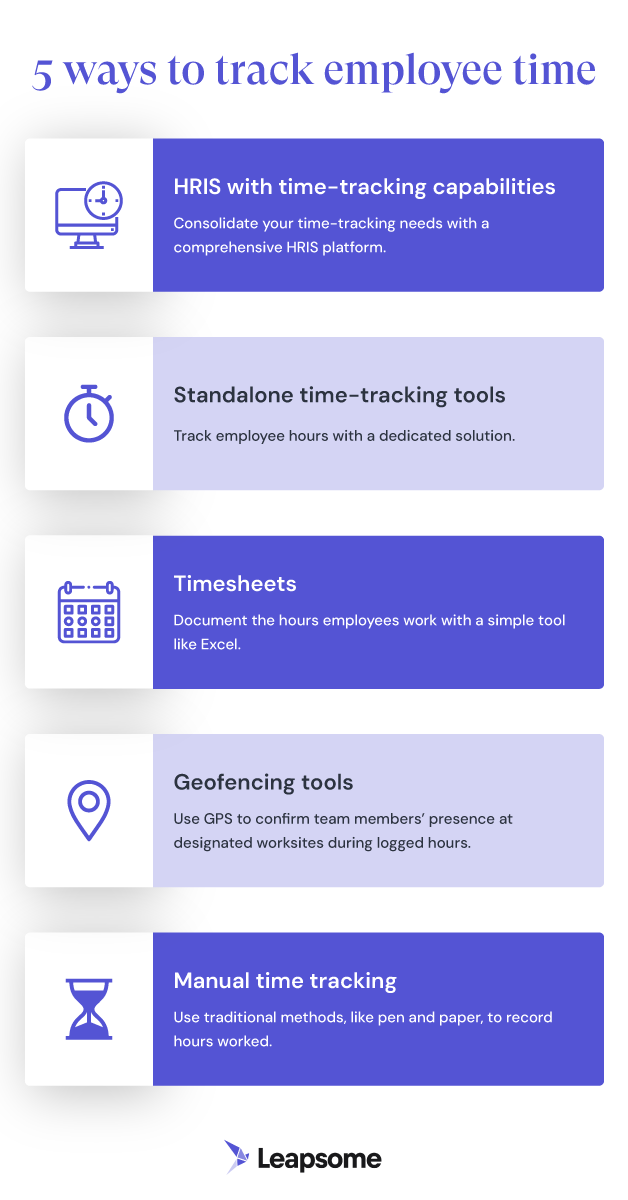So verfolgen Sie die Mitarbeiterzeit: Optionen, Tipps und Tools

Die Art und Weise, wie Sie die Arbeitszeiten Ihrer Mitarbeiter verfolgen, können einen wichtigen Beitrag zur Arbeitsplatzkultur und zum Geschäftsergebnis Ihres Unternehmens leisten. Richtig eingesetzt, können Zeiterfassungstools den Unterschied zwischen der Führung eines nachhaltigen Unternehmens und dem Versuch, profitabel zu bleiben, erkennen.
Allerdings sind nicht alle Zeiterfassungssysteme gleich aufgebaut. Ein durchdachter, benutzerfreundlicher Ansatz zur Zeiterfassung kann Ihrem Unternehmen helfen, strategisch zu handeln, Ressourcen fair zuzuweisen und Kunden präzise in der Abrechnung zu stellen. Auf der anderen Seite steht das Risiko, dass überdringliche Lösungen die Teammoral schädigen und Ihre Unternehmensrisiken im Zusammenhang mit Arbeits-, Datenschutz- oder Privatsphäregesetzen.
Angesichts der Tatsache, dass 85% der Personalleiter unter dem Druck stehen, Tech-Stacks zu konsolidieren*, ist es wichtig, dass Sie eine umfassende Zeiterfassungslösung finden. Die Herausforderung besteht darin, ein Tool zu finden, mit dem Sie herausfinden können, dass nicht nur die Bedürfnisse und das Budget Ihres Unternehmens, sondern auch ein unterstützter Ansatz, bei dem die Person an erster Stelle steht. Schließlich geht es bei einer effektiven Zeiterfassung nicht nur um Zahlen — es geht darum, einen ausgewogenen, produktiven Arbeitsplatz zu fördern.
In this guide is explained how the hours of the employees are recorded, and it is explained which effects can have quality time management apps. Wir werden auch kurz die wichtigsten Zeiterfassungsplattformen vorstellen.
⏳ Verbringen Sie weniger Zeit damit, Gedanken über... Zeit zum Zubereiten
Das HRIS von Leapsome macht die Zeiterfassung für alle Teammitglieder intuitiv und nahtlos.
👉 Erfahre mehr
*Bericht über die Belegschaftstrends von Leapsome, 2024
Warum ist die Erfassung der Mitarbeiterzeit für moderne, mitarbeiterorientierte Unternehmen wichtig?
Ein robustes Zeiterfassungssystem kann mehr als nur die Arbeitszeiten überwachen — es kann das Unternehmenswachstum und das Wohlbefinden der Mitarbeiter unterstützen. Es geht auch:
Unterstützung der Work-Life-Balance
Laut unserem Workforce Trends Report 2024 ist die Arbeitsbelastung für 71% der Manager und 63% der einzelnen Mitarbeiter (ICs) im letzten Jahr gestiegen. Zu den alarmierenden Trends gehört, dass über die Hälfte der von uns befragten Manager und ICs von einem verschlechterten Wohlbefinden berichtet wurde und 34% der ICs angaben, ihren Job kündigen zu wollen. Diese Statistik zeichnet ein besorgniserregendes Bild der Burnouts am Arbeitsplatz.
Eine genaue Zeiterfassung kann Managern helfen, Überlastung frühzeitig zu erkennen. Wenn ein Mitarbeiter beispielsweise häufig 12-Stunden-Tage protokolliert, ist das ein klares Zeichen dafür, dass er Unterstützung benötigt.
Mit diesen Daten können Manager die Arbeitsbelastung anpassen, Ressourcen besser zuweisen und Mitarbeiter bei Bedarf einstellen — und so ein bessere Work-Life-Balance.
Erhöhung der Genauigkeit der Gehaltsabrechnung
Genaue Zeitaufzeichnungen sind für einen Kritiker unerlässlich HR-Prozesse: Verwaltung der Gehaltsabrechnung, insbesondere für Stundenarbeiter.
Moderne Zeiterfassungssysteme helfen dabei, Fehler zu vermeiden und sicher zu stellen, dass die Mitarbeiter genau und pünktlich entlohnt werden.
Unterstützung bei der Einhaltung von Vorschriften
Die meisten US-Bundesstaaten und viele europäische Länder haben Arbeitsgesetze, die Bezahlung und die Pausen bei Überstunden regeln.
Zum Beispiel die Gesetz über faire Arbeitsstandards der Vereinigten Staaten (FLSA) verlangt von Unternehmen, dass sie Arbeitnehmer, die in einer einzigen Arbeitswoche mehr als 40 Stunden arbeiten, anderthalb Löhne zahlen, die nicht von der Steuer befreit sind. Um dieser Anfrage nachzukommen, stellt die FLSA vor diesem Unternehmen präzise Zeiterfassungsaufzeichnungen für ihre Mitarbeiter zur Verfügung.
In ähnlicher Weise unterstützt die Erfassung der Arbeitszeiten der Teammitglieder, die Einhaltung der Arbeitszeitrichtlinie der Europäischen Union (WTD), die Standardregeln für Arbeitszeiten, Pausen und Überstunden.
Die Einführung robusterer Zeitplanungspraktiken kann Unternehmen bei diesen gesetzlichen Anforderungen helfen.
Generierung von Erkenntnissen aus dem Projektmanagement
Es kann schwierig sein, die Zeit abzuschätzen, die für die Erledigung verschiedener Aufgaben benötigt wird. Einige benötigen zwei Stunden, während andere zwei volle Arbeitstage beinhalten können. Tools zur Zeiterfassung helfen Personalfachleuten und Managern dabei, genaue Daten über die Arbeitszeiten zu sammeln, was eine bessere Planung und Ressourcenzuweisung ermöglicht.
Und wenn Unternehmen mit diesen Daten ausgestattet sind, hilft das auch bei einer fairen, nachhaltigen Preisgestaltung. Ein Projektmanager kann beispielsweise feststellen, dass ein Team ungewöhnlich lange Arbeitszeiten für einen einzelnen Kunden arbeitet. Sie könnten diese Informationen dann verwenden, um einen höheren wiederkehrenden Honorarpreis zu besprechen.
Fünf Möglichkeiten, die Zeit, der Ihre Mitarbeiter folgen können: Finden Sie die beste Option für Sie
Zeiterfassung ist entscheidend für die Einhaltung der Vorschriften, die Zuweisung von Ressourcen und die betriebliche Effizienz. Da jedoch verschiedene Methoden und Tools zur Verfügung stehen, ist es wichtig, dass Sie auswählen, was den Anforderungen Ihres Unternehmens entspricht.
Lass' uns fünf beliebte Zeiterfassungsansätze vor diesem Hintergrund überprüfen.

1. HRIS-Software mit Zeiterfassungsfunktionen

Complein Personal Information Systems (HRIS) zentralisieren Sie eine Vielzahl von HR-Prozessen, wie Zeiterfassung, Abwesenheitsmanagement und Lohn- und Gehaltsabrechnung. Diese Integration macht HRIS-Plattformen ideal für Unternehmen und deren Prozesse und reduziert den Aufwand (und die Kosten) der Verwaltung mehrerer Tools.
Darüber hinaus wurden ganzheitliche HR-Plattformen wie Leapsome entwickelt Erfahrung des Personals im Hinterkopf. Sie machen es den Teammitgliedern einfach, ihre Arbeitszeiten zu protokollieren, eine Auszeit zu beantragen, Informationen zu finden und ihre persönliche Daten, und überarbeiten interne Updates.
Der Fokus auf Nutzerfreundlichkeit ist besonders wertvoll für die Zeiterfassung, da oft Eingaben der Mitarbeiter erforderlich sind. Denken Sie nur und je weniger Zeit und desto weniger Stress, wenn überpasste Zeiteingaben, Eingaben und andere oft erhebliche Probleme bei der Zeiterfassung nicht mehr zu Ihrem Arbeitsalltag gehören.
Profis
- Konsolidierte Zeiterfassung und andere HR-Aufgaben in einem System
- Skalierbar, um den Bedürfnissen wachsender Unternehmen gerecht zu werden
Lässt sich nahtlos in die Lohn- und Abwesenheitsverwaltung integrieren (je nach Anbieter)
Nachteile
- Kann teurer sein als ein eigenständiges Zeiterfassungstool
- Kleinere Unternehmen benötigen möglicherweise nicht den vollen Funktionsumfang
Bester Anwendungsfall
Ein HRIS mit Zeiterfassungsfunktionen ist eine hervorragende Option für jedes Unternehmen, dessen technischen Stack rationalisieren und die Arbeitsbelastung seines Personenteams reduzieren möchte (sodass das Unternehmen mit weniger mehr erreichen kann).
😍 Zeiterfassung und HR-Kernfunktionen an einem intuitiven Ort
Das umfassende HRIS von Leapsome kann Ihrem Team helfen, die Zeit einzuhalten und Ihre Ausgaben für andere HR-Tools zu reduzieren.
👉 Erfahre mehr
2. Eigenständige Tools zur Zeiterfassung
Eigenständige Tools zur Zeiterfassung sind ausschließlich für die Erfassung der Arbeitsstunden von Mitarbeitern konzipiert. Diese Lösung bietet in der Regel kein breites Spektrum an erweiterten HR-Funktionen und unterstützt auch nicht direkt andere HR-Prozesse. Diese Plattformen verfügen aber manchmal über grundlegende Funktionen in Bezug auf die Zeiterfassung, einschließlich Aufgabenverfolgung und Analyse.
Obgleich sie sich in ihrer spezifischen Funktion unterscheiden, müssen separate Tools zur Personalverwaltung in andere Systeme integriert werden. Ihre Einfachheit kann jedoch kleinere Teams oder projektbasierte Unternehmen ansprechen.
Profis
- Einige Plattformen verfügen über relevante Funktionen wie Arbeitszeittabellen und Projektverfolgung
- Sorgen Sie in der Regel für intuitive Benutzeroberflächen (UIs), die nur minimalen Schulungsaufwand erfordern
- Vis bietet möglicherweise mobile Apps für den Zugriff von unterwegs an
Nachteile
- Andere Plattformen sind für die volle HR-Funktionalität erforderlich
- Abonnementkosten können sich für größere Teams summieren
- Mitarbeiter finden es oft frustrierend, eigenständige Tools zu verwenden und mit mehreren Apps zu kombinieren
Bester Anwendungsfall
Eigenständige Zeiterfassungstools eignen sich am besten für Unternehmen, die ein einzelnes Problem lösen möchten (Zeiterfassung) und keine weiteren Funktionen oder Funktionen benötigen. Sie eignen sich möglicherweise auch gut für Teams, die stark auf Freelancer angewiesen sind.
3. Stundenzettel
Arbeitszeittabellen sind eine kostengünstige Methode zur Erfassung der Arbeitszeiten von Mitarbeitern — sie sind jedoch unzureichend, wenn es um Benutzerfreundlichkeit, Unterstützung bei der Einhaltung von Vorschriften und Fehlerreduzierung geht.
Dies funktionierte oft bei digitalen Tabellen wie Excel oder Google Sheets, auf die zugegriffen werden kann und die einfach zu implementieren sind. Da sie jedoch auf manuelle Eingaben angewiesen sind, können sie Fehler und Inkonsistenzen schnell summieren, was die genaue Gehaltsabrechnung und die Einhaltung gesetzlicher Vorschriften vor Herausforderungen stellt.
Aufgrund ihrer Einfachheit eignen sich Arbeitszeittabellen am besten für Arbeitsumgebungen mit einem geringen technischen Hintergrund. Zum Beispiel könnte eine kleine Bäckerei mit einigen Teilzeitbeschäftigten davon profitieren, Arbeitszeittabellen anstelle von ausgeklügelter Software zu verwenden. Arbeitszeittabellen sind jedoch umständlich, wenn die Teams wachsen oder die Zeitpläne komplexer werden.
Profis
- Minimale Einrichtungskosten und einfache Implementierung
- Einfach für Mitarbeiter und Geschäftsinhaber zu verwenden
Nachteile
- Anfällige Fehler und Inkonsistenzen durch manuelle Eingabe
- Hoher administrativer Arbeitsaufwand, insbesondere für größere Teams
- Es fehlt eine Automatisierung oder Funktionen zur Unterstützung der Einhaltung von Vorschriften
Bester Anwendungsfall
Stundenzettel eignen sich ideal für sehr kleine Unternehmen mit unkomplizierten Abläufen oder temporären Projekten, bei denen digitale Tools nicht praktikabel sind.
4. Geofencing-Tools
Geofencing-Tools verwenden GPS, um die Mitarbeiter an bestimmten Orten, wie z.B. Baustellen oder Außenanlagen, während der Arbeitszeiten des Protokolls zu überprüfen.
Das heißt, Geofencing stellt die Arbeitsplatzkultur vor großen Herausforderungen. Diese Tools können zwar in bestimmten Branchen (z. B. bei Lieferservices) wirksam sein, werfen jedoch Bedenken hinsichtlich des Datenschutzes auf und können sich für Mitarbeiter als aufdringlich empfinden. Dies kann sich auf das Selbstvertrauen, die Arbeitszufriedenheit und das allgemeine Wohlbefinden auswirken.
Personalleiter sollten die möglichen Auswirkungen von Geofencing auf die Teammoral und die Arbeitsplatzkultur sorgfältig abwägen. Vor der Implementierung müssen Unternehmen für Transparenz sorgen, die Zustimmung der Mitarbeiter einholen und die Datenerfassung auf Arbeitszeiten und bestimmte Bereiche beschränken.
Profis
- Überprüfte die Anwesenheit des Teams an bestimmten Arbeitsplätzen
- Kann das Ein- und Ausschalten vereinfachen
Nachteile
- Kann sich für Mitarbeiter invasiv fühlen, wenn es nicht sorgfältig umgesetzt wird
- Erfordert die strikte Einhaltung der Datenschutzbestimmungen
Bester Anwendungsfall
Dies kann für Unternehmen mit verteilten, standortspezifischen Teams praktisch sein, z. B. in der Baubranche, im Gastgewerbe oder im Lieferservice.
5. Manuelle Zeiterfassung
Bei der manuellen Zeiterfassung erfassen Mitarbeiter ihre Stunden (oder ein Vorgesetzter zeichnet Stunden für Mitarbeiter an) ohne Software. Dieser Ansatz mag für kleine, temporäre oder technologieorientierte Unternehmen funktionieren, ist aber für moderne Unternehmen selten nachhaltig.
Da die manuelle Nachverfolgung arbeitsintensiv ist, ist sie anfällig für Ungenauigkeiten und Ineffizienzen, insbesondere wenn Teams wachsen oder Arbeitsabläufe komplexer werden.
Profis
- Keine Softwarekosten oder Schulungen erforderlich
- In Low-Tech-Umgebungen zugänglich
Nachteile
- Sehr fehleranfällig und zeitaufwändig
- Unüberschaubar für größere Teams oder langfristige Projekte
Bester Anwendungsfall
Die manuelle Zeiterfassung eignet sich am besten für temporäre oder einmalige Projekte in Umgebungen, in denen digitale Tools nicht praktikabel sind, wie z. B. kurzfristige Einzelhandelsveranstaltungen.
3-personenzentrierte Zeiterfassungstools für Mitarbeiter
Die Wahl der richtigen Tools zur Zeiterfassung kann von Vorteil sein, um die Compliance-Anforderungen mit der Produktivität und Zufriedenheit der Teams in Einklang zu bringen.
Hier sind drei wichtige Optionen:
1. Leapsome

Die besten Funktionen
- Zeiterfassung mit anpassbaren Richtlinien — Teammitglieder können ihre Stunden und Pausen mühelos protokollieren, und Unternehmen können die Einhaltung grenzüberschreitender Vorschriften mit Richtlinien unterstützen, die an Unternehmensstandards und lokale Vorschriften gebunden sind.
- Zeiterfassungs-Widget — Die Mitarbeitererfahrung wird durch ein benutzerfreundliches Widget verbessert, das die Protokollierung von Stunden und Pausen vereinfacht. Das intuitive Design sorgt dafür, dass die Mitarbeiter weniger Zeit für Verwaltungsaufgaben und mehr Zeit für ihre Arbeit haben.
- Abwesenheitsmanagement — Die Zeiterfassung funktioniert nahtlos mit dem Abwesenheitsmanagement-Tool von Leapsome. HR-Teams können etwas erstellen und überprüfen Abwesenheitsmanagement Richtlinien und PTO-Workflows verwalten, während die Mitarbeiter auf einfache Weise Ihren Urlaub und Urlaub überprüfen können.
- Gehaltsabrechnung — Die Automatisierung der Verarbeitung von Arbeitszeitdaten hat auch damit die Gehaltsabrechnung die tatsächlichen Arbeitszeiten zur Folge, wodurch die Gehaltsabrechnung optimiert und Fehler reduziert werden.
- Zusätzliche HRIS- und People-Enablement-Funktionen — Die Zeiterfassungslösung von Leapsome ist Teil einer umfangreichen Suite von HR- und Engagement-Tools, darunter Kern-Personalwesen, Bewertungen, Umfragen, Lernen, und Tore.
Profis
- Umfassende Lösung für persönliches Engagement und Mitarbeiterengagement
- Intuitive, einfach zu bedienende Zeiterfassungsfunktion, die nur wenig Schulung erfordert
- Mehrere Integrationen verfügbar
- Flexibler Preis ab 3 US-Dollar (Benutzer/Monat)
- AI Copilot reduziert den Verwaltungsaufwand und ermöglicht es HR-Teams, sich auf strategische Initiativen zu konzentrieren
Nachteile
- Das Zeiterfassungstool ist etwas neu, also sollten Updates erwartet werden
2. Spur umschalten

Die besten Funktionen
- Automatisierte Zeiterfassung — Benutzer können das Projekt für die Stunden protokollieren, indem sie vordefinierte Aktionen ausführen (z. B. von einem Webbrowser zu einem anderen wechseln).
- Zeitschaltuhr — Mit der Online-Timer- und Stechuhr-App können Mitarbeiter ihre Arbeitszeiten genau protokollieren.
- Berichterstattung und Analytik — Mit dem Berichts-Dashboard von Toggl können Manager und andere Benutzer mit Berechtigungen detaillierte Zeitprotokolle protokollieren und die Projektleistung verfolgen. Mit dieser Funktion ist es auch möglich, Arbeitszeittabellen zu generieren.
Profis
- Kostenloser Tarif mit grundlegenden Zeiterfassungsfunktionen
- Bekannte Zeiterfassungslösung
- Einfache, benutzerfreundliche Oberfläche
Nachteile
- Einige Benutzer sind das Umschalten kann schnell teuer werden
- Einige Nutzer berichten, dass man mit der Benutzeroberfläche von Toggl leicht vergisst, ein- und auszuschalten
- Ziemlich enger Funktionsumfang im Vergleich zu umfassenderen Optionen
3. Uhrkifizieren

Die besten Funktionen
- Zeitmessung — Mitarbeiter können einen Timer verwenden, um ihre Arbeitszeiten zu verfolgen, oder ihre Stunden am Ende jeder Arbeitsphase manuell eingeben. Die Kioskfunktion von Clockify enthält auch mitarbeiterspezifische PIN-Codes.
- Zeitmanagement — Benutzer können PTO anfordern und ihre genehmigten Anfragen im Dashboard von Clockify einsehen.
- Berichterstattung — Der Manager kann Zeiteinträge auf verschiedenen Typen überprüfen, darunter die Clockify-Dashboards, benutzerdefinierter Aufschlüsselungen und Diagramme. Berichte können nach Projekt, Rate und Standort sortiert werden, um detailliertere Einblicke zu erhalten.
Profis
- Kostenloser Tarif mit grundlegenden Zeiterfassungsfunktionen
- Einfach zu bedienende Plattform
- Beliebt bei kleinen Unternehmen und Freelancern
Nachteile
- Der kostenlose Plan hat eingeschränkte Funktionen
- Einige Anwender berichten von Verzögerungen und Synchronisationsproblemen
- Einige Benutzer haben Probleme mit der mobilen App und inkonsistente Erfahrungen auf verschiedenen Geräten gemeldet.
🕵️ Es ist jede Software zur Mengenzeiterkennung auf dem Markt — aber Sie machen sich keinen Stress. Erkunden Sie unseren Leitfaden zum beste Zeiterfassungssoftware für Mitarbeiter des Jahres 2025 um ihnen zu helfen, Lösungen zu finden, um ihre Unternehmensanforderungen und Compliance-Ziele zu finden.
Die besten Tipps zur Erfassung von Mitarbeiterzeiten in Ihrem Unternehmen
Sobald Sie sich für eine Methode zur Zeiterfassung Ihrer Mitarbeiter entschieden haben, beginnt eine weitere Herausforderung: die Teammitglieder für Ihre neue Lösung zu gewinnen. Wenn Sie die folgenden Tipps befolgen, können Sie eine reibungslose Einführung sicherstellen:
- Priorisieren Sie das Buy-In — Wenn Teammitglieder zu einer wichtigen Entscheidung beitragen, ist es sehr wahrscheinlicher, dass sie das Gefühl haben, in das Endergebnis investiert zu sein. Das gilt für alle, von einzelnen Mitwirkenden bis hin zu den Führungskräften.
Binden Sie Ihr Team in den Entscheidungsprozess ein, um die Zustimmung zu fördern. Bitten Sie vor der Implementierung um Feedback zu Tools und Methoden. Dies bedeutet ein Gefühl der eigenen Verantwortung und bietet die Sicherheit, dass die gewählte Lösung von allen Seiten benötigt wird.
- Kommunizieren Sie Ihr „Warum“ — Warum haben Sie sich für eine bestimmte Zeiterfassungslösung entschieden? Die Transparenz Ihres Denkprozesses hilft Ihren Kollegen, den Wandel zu verstehen und zu unterstützen. Wenn Ihr bisheriges System beispielsweise routinemäßig zu ungenauen Gehaltsschecks geführt hat, erklären Sie, dass die Lösung dieser Probleme bei der Entscheidung der Personalabteilung geändert wurde, eine wichtige Rolle gespielt hat.
- Bieten Sie spezielle Schulungen an — Neue Arbeitsabläufe sorgen für Verwirrung, aber mit dem richtigen Training kann dein Team das neue Zeitleistungstool schnell und sicher nutzen. Sie erwägen die Verwendung einer Plattform wie Leapsome Lernen Trainingsmaterialien zu erstellen; dies gewährleistet die Sicherheit, dass jeder über die Ressourcen verfügt, die er für seinen Erfolg benötigt
Stellen Sie Ihre Mitarbeiter mit aussagekräftiger Zeiterfassungssoftware an die erste Stelle
Bis zur Hälfte des Personalleiters plant, ihren Tech-Stack bis 2026 zu aktualisieren. Zu den wichtigsten Treibern hinter diesem Trend gehören:
- notwendig ist eine erhöhte Personaleffizienz (von 89%, wie der Befragte angegeben hat)
- Verstärkter Fokus auf Compliance (51%)
- Mehr Unterstützung für die persönliche Strategie der Organisation (47%)
Ein robustes Zeiterfassungssystem kann zu jedem dieser Ziele beitragen. Mit einer effektiven Zeiterfassungsplattform können Personenteams Zeit sparen, auf genaue Daten zugreifen und interne Richtlinien und lokale Arbeitsvorschriften besser einhalten.
Umfassende Zeiterfassungslösungen wie Leapsome, bei denen der Mensch im Mittelpunkt steht, bieten zusätzliche Vorteile, z. B. ermöglichen sie es Managern, fundierte Entscheidungen über Arbeitsbelastung und Ressourcenzuweisung zu treffen. Dies setzt voraus, dass die Arbeitsmoral und das Wohlbefinden der Mitarbeiter verbessert werden, indem eine faire Aufgabenverteilung gewährleistet wird.
Sie denken vor allem daran: Zeiterfassungslösungen sollten funktionieren mit dein Team, nicht dagegen. Priorisieren Sie Tools, bei denen der Mensch an erster Stelle steht, und Sie werden Ihr Unternehmen auf Erfolgskurs bringen.
⏰ Mach die Zeiterfassung zu einem großartigen Erlebnis
Sie suchen nach einer intuitiven, benutzerfreundlichen Zeiterfassungsoberfläche? Es ist Zeit, Leapsome auszuprobieren.
👉 Book a demo
Haftungsausschluss: Dieser Artikel dient nur zur Information und bietet keine Rechts-, Steuer- oder Finanzberatung. Obgleich wir unser Bestes getan haben, um Rechtmässigkeits- und Vollständigkeits zu gewährleisten, können wir nicht garantieren, dass alles aktuell oder fehlerfrei ist. Wir empfehlen, sich für eine konkrete Beratung an einen qualifizierten Anwalt oder Steuerberater zu wenden.
Sind Sie bereit, Ihre Strategie zur Mitarbeiterförderung zu verbessern?
your People operations?
Informieren Sie sich über unsere Leistungsbeurteilungen, Ziele und OKRs, Engagement-Umfragen, Onboarding und mehr.
.webp)
.webp)
 Fordern Sie noch heute eine Demo an
Fordern Sie noch heute eine Demo an








.jpg)






















